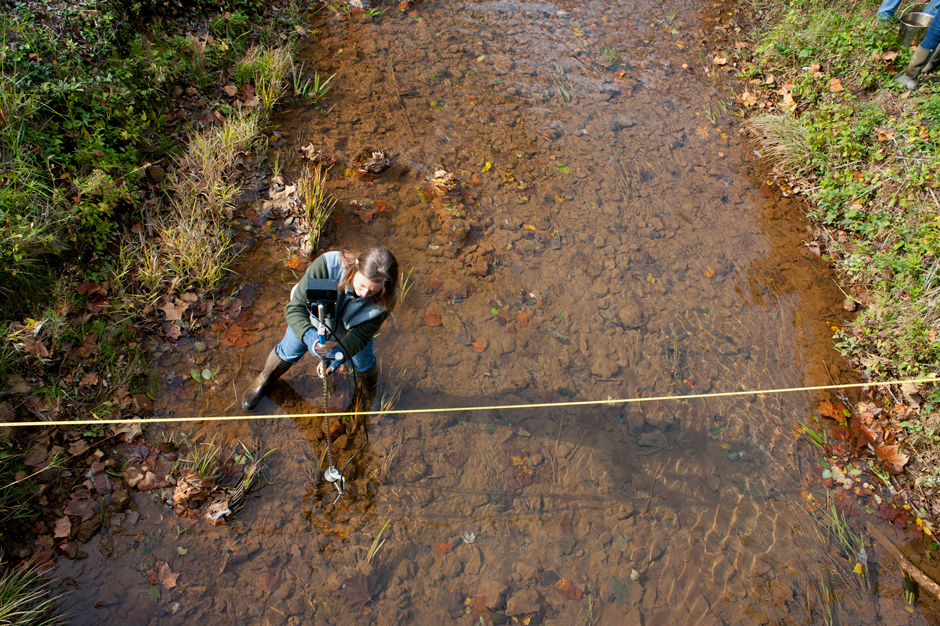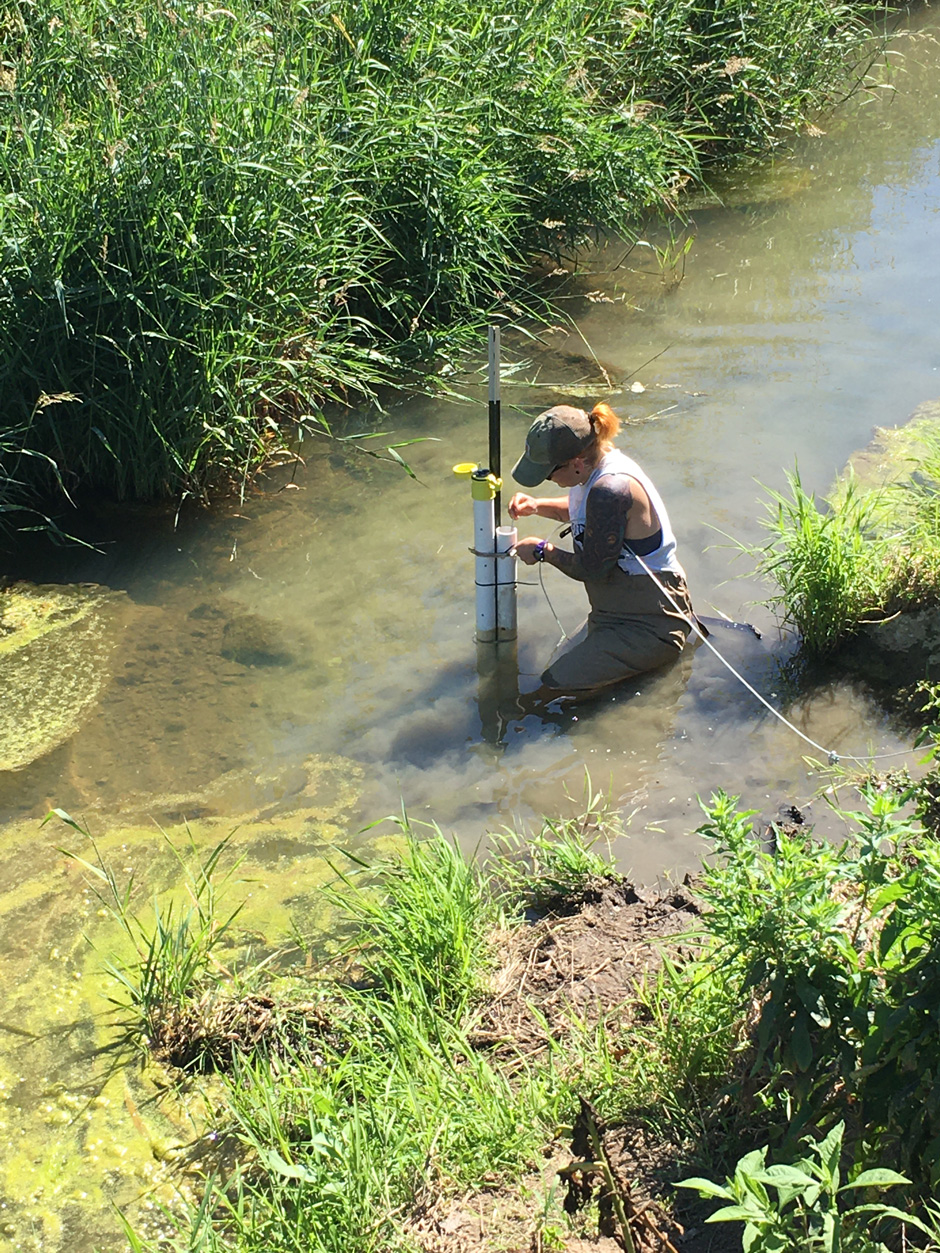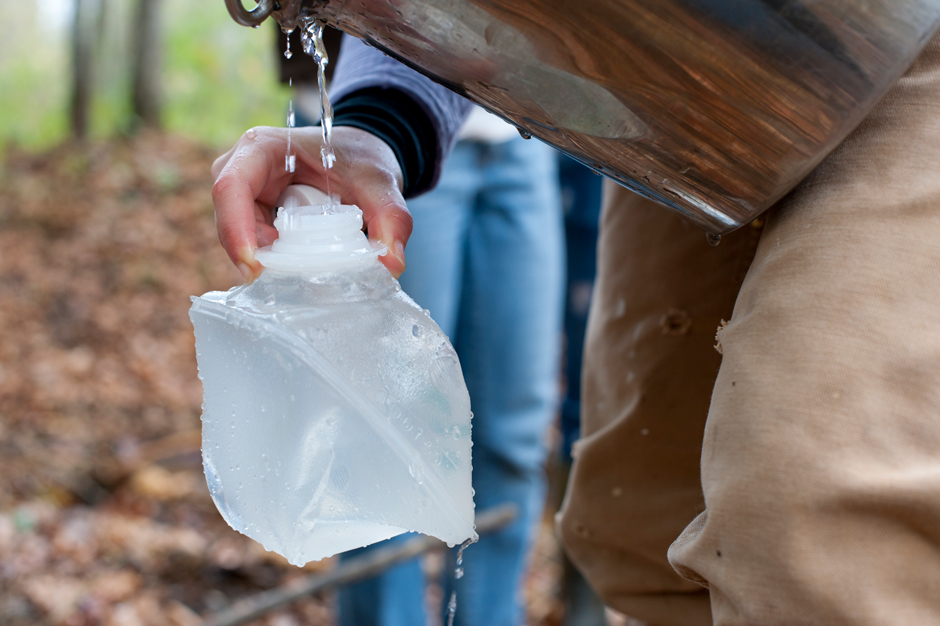Orange Stream Dreams: Monitoring Acid Mine Drainage and Watershed Health
 Jen Bowman, Ohio University, measures discharge in Hewett Fork an acid mine drainage impacted stream in the Raccoon Creek Watershed (Credit: Darcy Holdorf / Ohio University student)
Jen Bowman, Ohio University, measures discharge in Hewett Fork an acid mine drainage impacted stream in the Raccoon Creek Watershed (Credit: Darcy Holdorf / Ohio University student)Not many young people pondering careers come up with the words “acid mine drainage.” But Jen Bowman, Director of Environmental Programs at the Voinovich School at Ohio University, could not help but be fascinated by what she saw during her days as an Ohio University student collecting field samples. “My interest in acid mine drainage, and how it affects watersheds, goes way back to my undergraduate days,” she explains. “We saw firsthand how streams could be impacted by drainage from abandoned mines. Sometimes streams had such severe problems they turned orange. It was hard not to be struck by that. I was drawn in to the many associated challenges, keeping watersheds clean, and improving stream health.”
Bowman remembers spending a summer at Raccoon Creek in Athens, Ohio, with Dr. Mary Stoertz as her undergraduate advisor. In coordination with the Athens Soil and Water Conservation District and Wayne National Forest, she and three other students monitored the water quality at about 100 sites in the late 1990s. “Some sections of Raccoon Creek were nice, others were impaired, so the Raccoon Creek project was continued,” Bowman recalls. “Acid mine drainage, a legacy from when the mines fueled the Industrial Revolution back in the 1800s coal mining, was still having effects. Coal mining, H₂SO₄ production, and coal rich in iron pyrite were a few of the things that were affecting water quality in the Raccoon Creek areas we studied. We were seeing very acidic pH levels, as low as 2 and 3. Our findings inspired the Ohio Division of Natural Resources Division of Mineral Resources Management and the Office of Surface Mining Clean Streams program to continue the Raccoon Creek cleanup.”
Acid Mine Drainage Monitoring Equipment
Bowman and her team collect many types of watershed data. Data is used in part to assess the continuing impact of the coal mining once conducted in the area. Data collected includes laboratory water quality samples and field parameters such as pH and conductivity. SonTek Flow Tracker equipment is used to measure stream discharge. Some of the equipment used for stream data-gathering includes YSI data sondes, an EXO3, and a Myron Ultrameter. Equipment is used to measure total dissolved solids, turbidity, temperature, pH, conductivity, and dissolved oxygen. The Myron Ultrameter is used for oxidation-reduction potential, temperature, pH, conductivity, and total dissolved solids.
The acid mine drainage research is done in coordination with the ODNR Division of Mineral Resources Management. Stream restoration data collected includes information on flood plain connectivity, water level with Onset HOBO data loggers, field water quality parameters using a YSI multi-parameter meter, sediment samples, and salt tracing data (salt solution release based on stream size and measured conductivity allows for a formula to be used to account for interstitial flow).

Ohio University student, Nichole Mazzone, installing an Onset HOBO data logger in an agricultural stream in Licking County, Ohio (Credit: Jen Bowman / Ohio University)
Erosion is also measured using erosion bank pins. These data measure soil loss by measuring centimeters of exposed spray-painted rebar and utilizing metal detectors to find them. In this way, it is possible to quantify how much soil is lost. HOBO data loggers are also used to measure the depth and temperature of a stream, and these are installed directly into the stream with fence posts, PVC pipes and/or cinder blocks.
Bowman also collects data on the height of water in the water column. Water column data is taken in 5-minute intervals. Sediment data is gathered for streams using a rack, much like a dishwasher tray with open bottles attached. The open bottles in the tray are anchored with zip ties. Alloway Laboratory analyzes the resulting bottled sediment. Additional analysis conducted at Ohio University includes dry weight and grain size using sieve analysis methods.
In terms of watershed data collection goals, Bowman and her team have many. “There are lots of environmental projects. However, our projects are defined by our partner’s needs,” she says. “I am happy to say they have been, and still are, committed to long-term projects at Raccoon Creek and across Appalachian watersheds.”
Long-Term Monitoring in Raccoon Creek
One of the long-term Raccoon Creek projects is monitoring for acid mine drainage in terms of a suite of parameters such as acidity, metals, and pH. About $17 million in funding has been used for restoration, including passive and active treatment systems. Passive treatment means using natural means such as wetlands for restoration. Active treatment means using calcium oxide released from a doser system. Active treatment for acid mine drainage involves continuously releasing calcium oxide powder into the water at a specific dose, creating an alkaline solution that treats acid mine drainage sources.
The goal is to maintain appropriate pH, alkalinity, and metal levels. In addition, it is also the goal of Bowman’s programs to align with funders’ quality objectives. Measurements are taken before and after both passive and active treatment to assess best management practices. Some of the data collected is used to monitor treatment systems that inform maintenance and repair.
Conclusion
Bowman’s team has many aquatic environmental improvement goals, some dating back to 2010. “Back then, one goal was to reduce acid mine drainage by 20%, and another goal was to restore streams to warm water habitats,” Bowman recalls. “Back in the 1970s and 80s, these goals were not being met.” A big goal was to restore the main stem of Raccoon Creek: Bowman and her team have achieved that goal as of 2022. Bowman credits Amy Mackey as a major partner in this achievement.
Bowman advises, however, that some headwater sections of the creek will always be treatment zones. Currently, the Ohio EPA’s total maximum daily load report shows much improvement in Raccoon Creek. “The new report has been a great way to highlight how monitoring and partnerships work together to achieve big water quality improvements,” Bowman notes. Furthermore, the Ohio Watershed Data program allows the public access to acid mine drainage abatement and treatment plans, says Bowman. There is also a citizen science program called “My Backyard Stream,” which allows kids to gather data and share it publicly.
Bowman and her team also have a lot of plans for the future. They are currently hard at work creating a plan for Rush Creek, Western Pennsylvania stream restoration and floodplain reconnection, as well as plans for Licking County’s Bloody Run Swamp. In addition to those projects, there are plans for riparian corridor efforts and tree planting work, and the gathering of monitoring data will continue.
Bowman mentions that there are many ways students and other citizens can help with the highly beneficial stream work they are doing. “There are lots of internships and volunteering opportunities,” she emphasizes. “I always tell people to volunteer even if there are no internships available yet…there are lots of watershed job positions open right now, it’s a good time to start a career in protecting and restoring waterways.”

Filling a sample bottle for laboratory analysis in Raccoon Creek Watershed (Credit: Darcy Holdorf / Ohio University)




Pingback: Environmental Monitor | Orange Stream Dreams: Monitoring Acid Mine Drainage and Watershed Health - News
Pingback: FishSens Magazine | Environmental Impacts of Mountaintop Removal Mining - FishSens Magazine